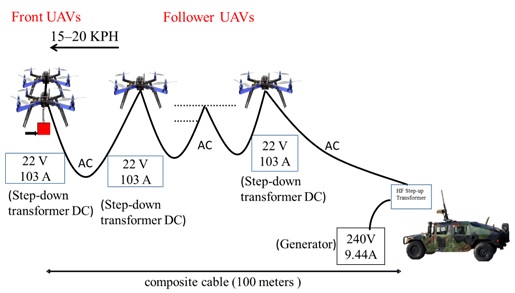Difference between revisions of "Vanguard UAV System to Transport Mine Sensors"
(→Problem Statement) |
|||
| Line 44: | Line 44: | ||
Pictorial Representation of the Power Analysis for the UAV’s: - | Pictorial Representation of the Power Analysis for the UAV’s: - | ||
| − | [[File:Power Distribution for the fleet of drones.jpg]] | + | [[File:Power Distribution for the fleet of drones.jpg|Power Distribution for the fleet of drones]] |
==Formation Methods== | ==Formation Methods== | ||
Revision as of 21:43, 11 May 2016
Problem Statement
Mines are a huge problem. We need a new solution to safely guide army vehicles through mine prone areas and in GPS denied environments.
Power Method
In the project we need to have 5 drones flying in the formation in order to satisfy the specification given by the night vision lab. Hence, in order to do that we need 5 drones with a power consumption of 9102 watts. Now with addition of 25% safety factor power consumption reached to 11377.5 watts. This power consumption gives 512.5 A as the current requirement for 5 drones, whereas voltage consumption remains to 22.2 V. So, for one drone current and voltage consumption is 102.5A and 22.2 V respectively.
Here is the power calculation for the fleet of UAVs:-
Current consumed by 1 UAV = 82 A Current consumed by 5 UAV’s = 410 A Voltage required = 22.2 V Power Consumed by 6UAV’s = Voltage * Current
= 22.2 * 410
= 9102 Watts
Safety Factor included = 25% Therefore, new Power is 11377.5 Watts So, Voltage requirement is 22.2 V
Current requirement is 512.5 A (for 5 UAV’s)
For 1 UAV Current consumed = 102.5 A Voltage Consumed = 22.2 V
Wire and its weight calculation: We are using thinnest wire possible which came out to be 18 gauge composite shielded copper cable and we also required to have 4 fiber optical cable for communication. After going over various cable manufacturers we came across the specification of this shielded cable provided by the manufacturer: [1] 42 lb. weight is for 1000 ft. of composite cable. 1000 ft. = 42 lb. 328 ft. or 100 m = (42/1000) * 328
= 13.77lb. or 6.24 Kg
This weight of wire will be distributed equally by the 5 UAV’s
After having the cable specification and the power requirement of the UAV, we did the following calculations for
Power transmission: High current output generator will be used with o/p of 9.44 A at 240 V Then it will be stepped up using step-up transformer to 280 V at 8.13 A of current. The reason for using step up transformer is because our shielded power cable is can control maximum current of 20 A in totals at 300 V. Hence for long transmission current will drop, so to maintain the right current value for the UAV higher voltage is required through step up transformer. On-board step down transformer on each UAV will step down the high voltage to 22.2 V and give each UAV 102.5 or 103 A of current.
Pictorial Representation of the Power Analysis for the UAV’s: -

Formation Methods
We proposed two methods for formation keeping. The firs tone is the catenary method which uses a the powercable to keep distance and keep orientation. The second method is the Trilateration method which uses L-CAS ranging sensor to measure distances between each robot.
Catenary
Adrian and Sailesh
Trilateration
Parth and Raghu